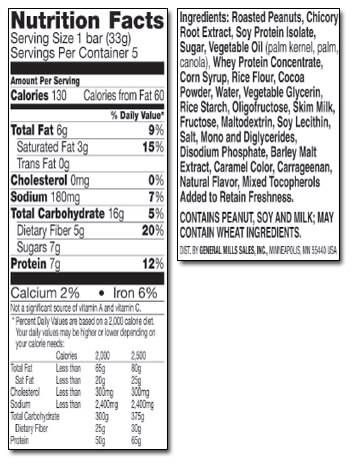Why Food Labels Are So Misleading
Even when accurate, they may not reflect good choices
If you care about your health and pay attention to nutrition, then you probably read the labels on the back of the packaged food products you buy. Would it surprise you to learn that in doing so, you might actually be making yourself less healthy? In fact, many of us are misled into buying products that are just plain bad for us.
Package Marketing Has Evolved
The fact that food companies use their product packaging as a marketing tool is not news to anyone. We all know that words like “natural,” “low-fat” and “reduced-calorie” are plastered onto all kinds of products to create the so-called “health halo” effect. The savvy, nutrition-minded consumer has adapted; your first instinct now is probably to flip the package over and read the Nutrition Facts and ingredients list.
While that’s a step in the right direction, food companies have caught on. So perusing the label is no longer enough to ensure that you’re buying a healthy product, rather than dressed-up junk food.
To start with, food manufacturers have found ways to make the numbers listed in the Nutrition Facts table look better. They’re also playing around with ingredients in hopes of convincing consumers that their products are healthier than they really are.
These tactics are often reflected in snazzy new marketing words emblazoned on the front of packages as well: “High-fiber,” “high-protein” and “whole grain” are a few of the food industry’s current favorites. Responding to consumer demand for healthier products, food manufacturers have begun using whole grain ingredients and adding fiber and protein to nearly everything. At first glance, this does seem like an improvement. After all, how can whole grains and more fiber and protein be a bad thing?
Drilling Down
In the case of whole grains, there is an actual benefit to choosing products that retain all those healthy parts of the grain. Unfortunately, there’s no regulation dictating what percentage of grains needs to be whole in order to call the product “whole grain.” You end up with many processed foods high in sugars and refined carbohydrates labeled as whole grain because they contain a tiny amount of whole grains.

Where protein and fiber are concerned, the situation is even worse. To see why, let’s take a look at this food label (above).
It's the Nutrition Facts and ingredients list for a very popular high-protein, high-fiber snack food. When shopping around for a snack food looking for fiber and protein, you might quickly scan this label, see that it has 7 grams of protein and 5 grams of fiber, and determine that it’s a pretty healthy option. So you buy it and eat it whenever you’re hungry for a snack or when you want to get more fiber or protein into your diet.
What you may have missed, though, is that the fiber and the protein come from ingredients you would never eat on their own. There’s chicory root extract to add fiber, and soy protein isolate and whey protein concentrate to boost the protein content. If you read a little bit closer, you’ll see that there are also no fewer than six sweeteners and several things that sound more like chemicals than ingredients in this “healthy” snack food.
With its added fiber and protein, this product may be a tiny bit healthier than its competitors. But here’s the real problem: You are eating these ingredients — chicory root extract, soy protein isolate and whey protein concentrate — as part of a caramel flavored, chocolate-covered peanut bar, instead of as components of whole foods.
You Want What You Don’t Need
The drawbacks to eating processed foods that have been packaged as “healthy” can be significant.
To begin with, the marketing health halo can lead to weight gain. A 2015 study conducted at the Cornell Food and Brand Labs found that when subjects ate a food portrayed as healthy, they ate more calories than when the same food was portrayed as unhealthy. The researchers concluded that people feel less full after eating something they perceive as healthy, so they eat more of it to compensate.
Eating packaged foods labeled as high in fiber can negatively impact our health, too. Researchers conducting a 2013 study examining the cardio-protective effects of fiber in the diet cautioned that their findings related only to fiber from food intake and not from fiber isolates or extracts. Authors of another study on the benefits of fiber explained in their abstract summary why we should try to get our fiber from whole foods rather than extracts or supplements: “Fiber is but one component of plant food, and to neglect the other components — be they proteins, lipids, vitamins, minerals, antioxidants, or the secondary metabolites — is to seriously limit our understanding.”
In other words, if you’re turning to low-nutrient packaged foods to meet your fiber intake, you’re missing out on the many other health benefits that whole foods have to offer, some of which may be even more important to your health than the fiber content.
The issue with protein is as much economic as it is nutritional. The prevailing attitude is that if more protein is not better, it’s at least not harmful, but that may not be the case. A large, 10-year European study found that a high-protein, low-carbohydrate diet was associated with increased mortality risk compared to a high-carbohydrate diet. There is a reason why the Centers for Disease Control have launched a campaign to increase consumption of fruits and vegetables, but not for protein; we’re getting plenty of protein, but eating far fewer servings of fruits and vegetables than we should be. Yet time and again we happily spend our grocery dollars on packaged foods with labels that boast a high protein content.
Choose the Real Thing
As I say time and again in my weight loss book, Reboot Your Body, what we need to be spending those dollars on instead are nutrient-dense whole foods. If you have a legitimate need for more protein or fiber in your diet, you could get more of both in a half cup of lentils than you can in that snack bar. What’s more, the fiber and protein in the lentils come with more iron, less fat and fewer calories.
If you don’t have 15 minutes to make a pot of lentils or just like things that are wrapped in pretty packaging, you needn’t despair. There is a growing number of brands offering minimally processed packaged foods made entirely of whole food ingredients.
So, don’t stop reading food labels — just start being much more critical when you do. Look for foods with few ingredients, or, best of all, turn to the produce aisle when shopping for your meals and snacks.


